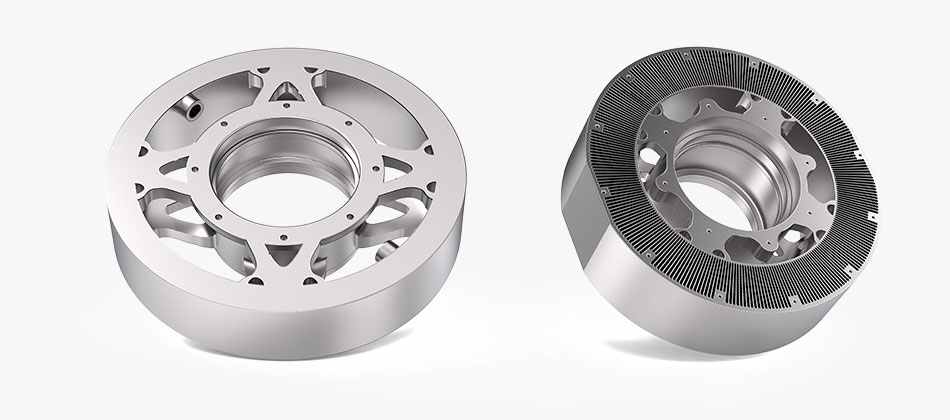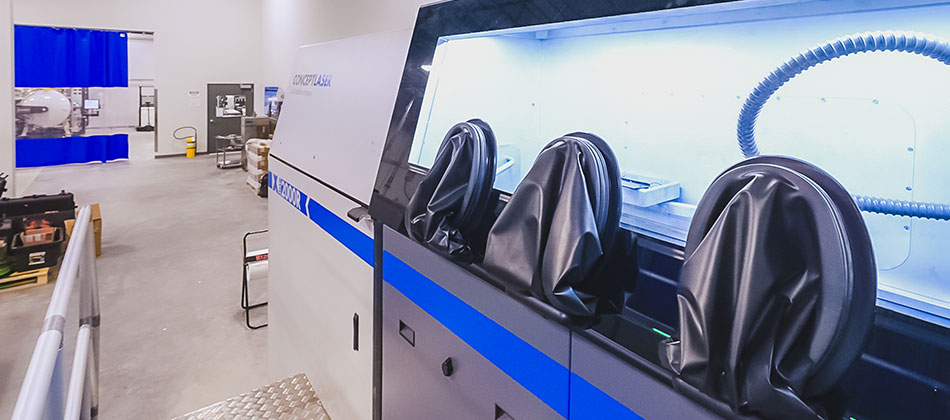Helping Electrical Engines for Aircraft Soar
Hinetics works with Protolabs to 3D print two designs for large heat sinks
Mankind has flown in powered aircraft for more than a century, and the vast majority of those flights have been accomplished using internal combustion engines. Aeronautic fuels have contributed to high-altitude pollution, introducing greenhouse gases into the stratosphere and speeding climate change.
Today, a new paradigm is developing in air travel, featuring clean-running, electrically powered engines. In 2017, Dr. Kiruba Haran spun-off a new company from the University of Illinois and its intention was to research, develop, and advance the use of electrical engines to power aircraft. He founded Hinetics, a portmanteau of HIgh-frequency and high field electro-magNETICS. The company also builds large-scale generators based on superconducting technologies, so Hinetics’ products cover both consumption and generation.
The difficulties in developing an electric engine that can efficiently run for long distances are anything but minor. Research and development continue, and Hinetics is at the center of it all.

Hinetics turned to additive manufacturing for its lightweight, air-cooled heat sink.
CHALLENGE: The Heat Is On
Hinetics core idea is one of aircraft electrification, but they also offer powertrain solutions for hybrid (electric/internal combustion) engines. As a startup, they have the opportunity to offer their advanced technologies in settings beyond aircraft. Ultimately, their aim is to create electric machines with specific high power and efficiency, and aircraft are the first industry they are tackling by providing electric solutions to forward-thinking companies.
“If somebody wants to create an electric plane and wants to fly it, they know the aerodynamics of the plane and they know where to put the mass,” said Peter Xiao, Hinetics electrical engineer. “But they don't know how to make a motor that's light enough to put on the plane. That’s why they may order one from us. It’s a very deep collaboration.”
All engines produce heat that needs to be dissipated for the engine to function. While internal combustion engines achieve about 30-40% efficiency, Hinetics engines typically achieve north of 95% in real-life testing. Though electric motors produce far less waste heat than internal combustion engines, they face much more stringent thermal management requirements to maintain electrical insulation.
One way to wick away heat is via liquid cooling. As a heat-transfer medium, the liquid assists with dissipation of heat from active components, such as the motor. The trouble is that liquid is heavy, and electrical vehicles—whether cars, trucks, or airplanes—are already carrying lots of weight in batteries alone. Hinetics goal was to find a way to lightweight parts whenever possible because lighter parts translate into increased flight range. Their first design used water cooling. That heat sink, while very efficient, is probably better suited for a system with existing liquid circulation such as a hybrid vehicle with an internal combustion engine.

This GE X Line printer allows for large-format metal parts like the Hinetics heat sink.
SOLUTION: Large-Format Metal 3D Printing
Hinetics had two choices for manufacturing these parts, casting them or using 3D printing. Because lead times for casting can stretch out weeks, 3D printing was the logical choice, even with a part this large. Another advantage of 3D printing was the geometric flexibility it provided. Using aluminum was a given, thanks to its high thermal conductivity and its comparative light weight.
First, Protolabs printed the water-cooling heat sink, and the new iteration a half-year later. The later version uses an air-cooling scheme that does not depend on external coolant. The air-cooling heatsink includes dozens of aluminum fins supporting the armature windings from the center bearing hub—the heart of the engine. Excessive heat in the armature windings is conducted through the aluminum fins towards the center. As the motor spins, an impeller fan located close to one end of the motor pumps air through the aluminum fins and dissipates the heat. The air-cooled heat sink is about 50% longer in axial dimension than the liquid-cooled one, in part to achieve efficiency and performance specifications.
“What’s great about the X Line is that it lets us create some of the most complex, large metal parts possible,” said Eric Utley, Protolabs 3D printing applications engineering manager. “The complexity allows you to both reduce material usage and increase surface area, as was the case with these parts, which have a tremendous amount of built-in functionality.”
There was one small design complication, however. The limitation of one of the axes on the printer is 15.7 in. (400mm). That’s still huge, but Hinetics’ part specifications needed 15.91 in. (404mm). Working with Protolabs, Hinetics slightly changed their design on two sides, flattening out the circular shape by 2mm on each. That small concession allowed them to pursue direct metal laser sintering (DMLS) on our GE X Line 2000R printers, which use two lasers simultaneously, making for huge decreases in turnaround time.
You can see that minor design adjustment in the part render and video. Our applications engineers met with Peter to discuss potential build risks due to the overall design of the part as it relates to X Line technology. Overall, working with Protolabs proved smooth sailing for Peter and team.
“…We organized a meeting almost right away—it was the second day,” said Xiao. “We talked about it and we discovered that we could easily just cut into the part to fit this 400mm [limitation] and we could move on.”
OUTCOME: Parts That Are Ready to Fly
As an offshoot of a major research university, the rules behind the research method are always on the minds of the team at Hinetics. Using Protolabs for both parts allowed the company to consider that aspect of development as a controlled variable because they used the same machine and material, and only changed the prototype design.
Hinetics’ air core permanent magnet machines are an intermediate step, on the way to offer fully air-core, virtually loss-less superconducting machines. The ultimate aim is to reinvent electrical machines with high-efficiency and high-power density.
| At A Glance |
|---|
|
Hinetics needed to create two very large, geometrically complex heat sinks for its permanent magnet electric motors that would dissipate the substantial heat generated by these engines. The parts needed to be precise in dimension and lightweight, with a high level of thermal conductivity and structural strength. Protolabs pushed our powerful, dual-laser GE X Line 2000R 3D metal printers to the limit of their size capacity, creating strong, but lightweight, aluminum parts. Starting with a water-cooled model, the team’s latest iteration uses air cooling with extensive narrow fins designed to wick away engine heat.
Both parts were printed effortlessly, with one of the dimensions butting up against the dimensional limits of the printer (400mm x 500mm x 800mm) without issue. Hinetics will test and evaluate these parts with additional iterations to come. |





